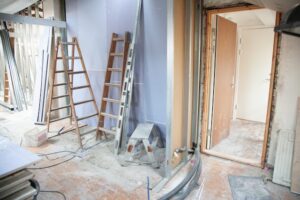
Owning a property is an exciting milestone. Yet, it comes with the responsibility of maintaining various elements of the house to ensure it stands the test of time. This guide will walk you through important components like the roof, siding, foundation, landscape, and floors. By understanding these critical areas, you’ll be well-equipped to keep your home in excellent condition.
Understanding Your Roof’s Importance
The roof is one of the most vital parts of your home, protecting everything underneath from the elements. It’s crucial to inspect and maintain it to avoid costly repairs later regularly.
Spotting potential problems early can save you a lot of trouble. Look for missing or damaged shingles, and be mindful of any leaks or water stains on your ceilings. These could be signs that your roof needs attention.
Routine maintenance includes cleaning gutters and downspouts to prevent water damage, as well as regular inspections from pros like Upside Roofing & Siding. Keeping debris off your roof and trimming overhanging branches will also extend its lifespan.
Keeping Your Roof in Top Shape
Maintaining your roof involves regular checks and professional inspections. Scheduling an annual roof inspection can catch issues before they become serious problems.
Ensure your attic has proper ventilation to prevent moisture buildup, which can lead to mold and mildew. Proper insulation also helps in maintaining the roof’s integrity.
Consider the climate of your area when choosing roofing materials. Some materials perform better in certain weather conditions, so it’s essential to pick the right one for your home’s location.
Siding Maintenance Basics
Siding not only enhances your home’s curb appeal but also protects it from the elements. Different types of siding require specific maintenance routines to keep them looking their best.
Cleaning your siding at least once a year helps to remove dirt, mold, and mildew. Use a soft brush or pressure washer on a low setting to avoid damage. Inspect for any cracks or gaps that could allow moisture to seep in.
Painting or sealing wood siding can protect it from rot and pests. Vinyl siding, while low-maintenance, can become brittle in extreme temperatures, so check for any damages after harsh weather.
Best Practices for Siding Upkeep
Regular inspections help identify issues before they escalate. Look for signs of wear, such as fading or warping, and address them promptly.
Repairing small problems quickly can prevent them from turning into significant issues. For instance, caulking gaps or replacing damaged sections can save you from more extensive repairs later.
Choose high-quality materials and finishes to ensure your siding lasts longer. Investing in good products initially can reduce the frequency of maintenance and replacements.
Foundation Fundamentals
The foundation is the backbone of your home, supporting the entire structure. Keeping it in good condition is vital for the stability and safety of your property.
Regularly inspect your foundation for cracks or signs of shifting. These could indicate underlying issues that need immediate attention. Check both the interior and exterior walls for any abnormalities.
Ensure proper drainage around your home to prevent water from pooling near the foundation. Water can seep into cracks and cause significant damage over time.
Preventative Measures for Your Foundation
Installing gutter extensions and French drains can help divert water away from your foundation. This prevents water buildup and reduces the risk of damage.
Keep an eye on trees and shrubs planted near your home. Their roots can grow into the foundation, causing cracks and structural issues. Trim or relocate them if necessary.
Consult a professional like Risen Foundation Solutions if you notice any significant cracks or shifts. They can provide expert advice and solutions to prevent further damage and ensure your home’s stability.
Landscaping Tips for New Homeowners
Landscaping enhances the beauty and value of your home. However, it requires regular upkeep to maintain its appeal and prevent issues that could affect your property.
Plan your landscape with both aesthetics and functionality in mind. Choose plants that are suitable for your climate and soil type, and consider their mature size to avoid overcrowding.
Regularly trim bushes and trees to keep them healthy and prevent them from encroaching on your home. Remove any dead or diseased plants promptly to maintain a vibrant and attractive landscape.
Watering and Mulching Essentials
Proper watering is crucial for a thriving landscape. Water your plants deeply but infrequently to encourage deep root growth. Use mulch to retain moisture, suppress weeds, and enhance the soil’s quality.
Avoid over-watering, as it can lead to root rot and other issues. Consider installing a drip irrigation system to ensure consistent and efficient watering.
Mulch your garden beds annually to replenish nutrients and maintain a neat appearance. Organic mulches like wood chips or straw are ideal for their added benefits to the soil.
Flooring Maintenance Tips
Floors endure daily wear and tear, making their maintenance essential for a clean and comfortable home. Different flooring types require specific care routines to keep them looking their best.
Regular sweeping or vacuuming removes dirt and debris that can scratch and damage your floors. Use appropriate cleaning products for your flooring type to avoid any harm.
Protect high-traffic areas with rugs or mats to reduce wear and tear. These also help in trapping dirt and moisture, keeping your floors cleaner for longer.
Prolonging the Life of Your Floors
Use furniture pads to prevent scratches and dents on your floors. Rearrange furniture periodically to distribute wear evenly across the surface.
Address spills and stains promptly to prevent permanent damage. For hardwood floors, avoid excessive moisture and use a damp mop instead of a wet one.
Consider refinishing or re-carpeting areas that show significant wear. This not only improves the appearance but also extends the life of your flooring.
Creating a Maintenance Schedule
Keeping track of all these maintenance tasks can be overwhelming. Creating a schedule ensures you stay on top of everything and prevent issues from escalating.
Divide tasks into monthly, quarterly, and annual checklists. This way, you can manage them more efficiently and make them part of your routine.
Seek professional help for tasks that require expertise. Regular inspections by professionals can catch problems you might miss and provide solutions before they worsen.
The Benefits of Regular Maintenance
Routine maintenance saves you money in the long run by preventing major repairs and replacements. It also ensures your home remains safe, comfortable, and valuable.
A well-maintained home provides peace of mind, knowing that your investment is protected. It also enhances your living experience, making your home a pleasant place to be.
Taking a proactive approach to home maintenance fosters a sense of pride and accomplishment. It reflects your commitment to preserving your property and creating a welcoming environment.
Summing Up Your Homeowner Journey
Owning a home is both a privilege and a responsibility. Understanding the framework of your home and maintaining it diligently ensures it remains a safe and pleasant haven for years to come.
From the roof to the foundation, each element plays a crucial role in your home’s overall health. By following the tips and advice in this guide, you’ll be well-equipped to handle any maintenance challenges that come your way.
For personalized advice and assistance, consider reaching out to professionals who can help you refine your maintenance routine and address specific concerns. Welcome to the rewarding world of homeownership!


